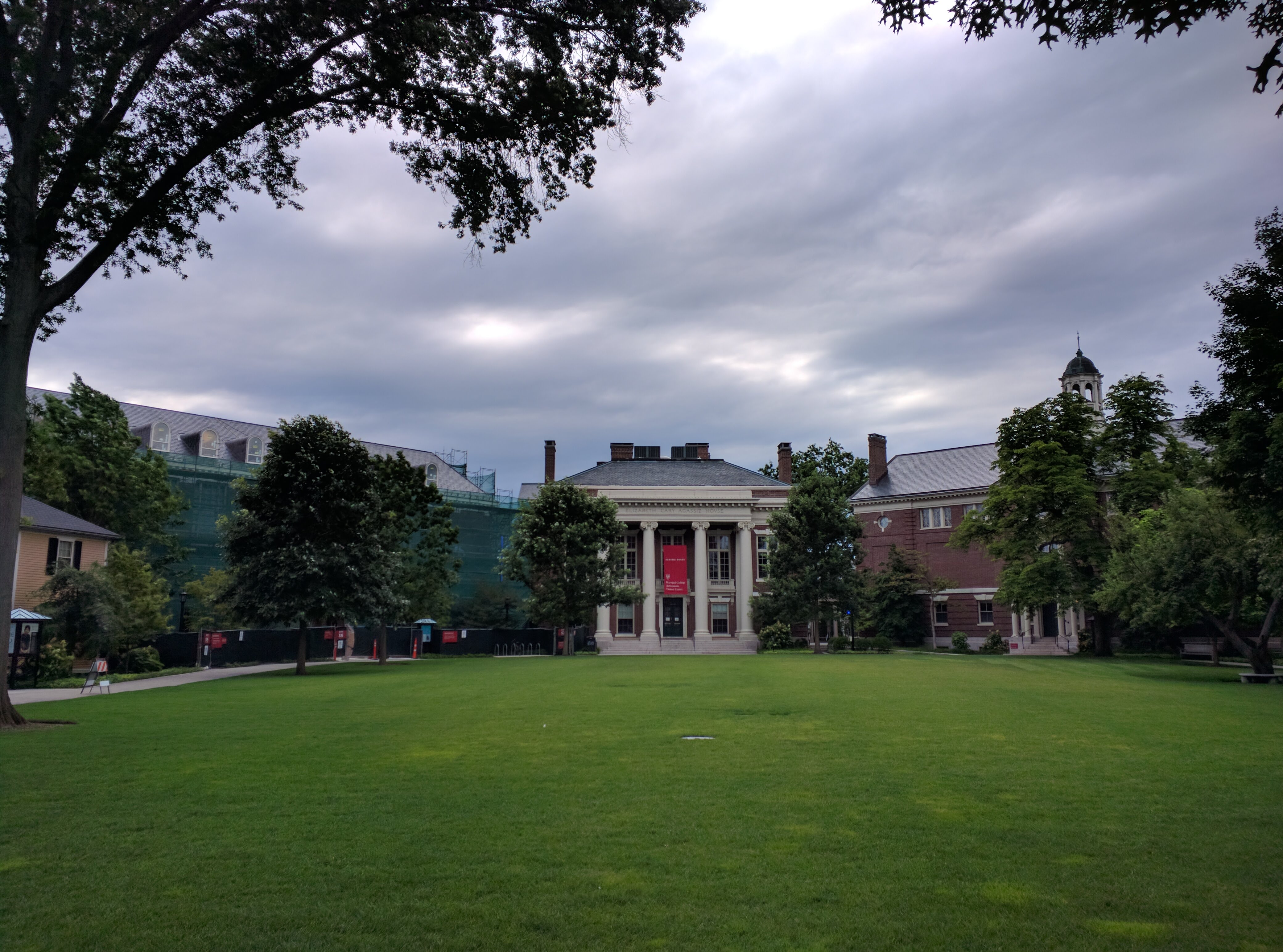Understanding the Midwest on its own isn’t enough — we need to go beyond the region to see how it was defined externally and within national campaigns, organizations, and scholarship. And Boston’s got a wealth of resources for scholars of politics, activism, and–yes–the Midwest.
I should note, first, that this is my second research trip to Boston: You might notice from my “Where I’ve Been” map that I was here in October 2017 to research the Michael Dukakis papers at Northeastern and the Tip O’Neill papers at Boston College; I also parlayed a free day created by frustration with the Dukakis records into a daytrip to Lowell and the records of Sen. Paul Tsongas (D-MA). I never wrote that trip (or my other trips funded by the Marquette History Department to Atlanta and Boulder) up for this blog.
Now, though, I was received a generous research grant from the New England Research Fellowship Consortium, a collaboration among 27 archives, universities, and historical societies in New England. A special thank-you to Katy Morris of the Massachusetts Historical Society and the staff at all the member institutions for their support.
You’re thinking “What the heck does a Midwestern historian have to do with–or need from–New England?!” And you’re right to think that!
Early on in my research, though, I learned of a congressional group called the Northeast-Midwest Congressional Coalition. While we think about the “Blue Wall” in modern Democratic politics (or thought about the Blue Wall before 2016), that’s an older concept with long-running congressional cooperation. The NMCC, created in 1976 by 18 members of Congress from both sides of the political aisle, has turned, by 2016, into a hundred-member behemoth. But its origins–and those of the fabled Blue Wall of Democratic support from New England through the Great Lakes–require us to understand better the points of cooperation, contention, and collaboration among not only politicians, but activists throughout the Northeast-Midwest corridor (stretching, if you really want, into modern politics).
And that’s where, I argued in my grant and my own research, we can do better to understand Midwestern political culture. I try to build, in my own work, on scholarship of historians like Lily Geismer, whose Don’t Blame Us! Suburban Liberals and the Transformation of the Democratic Party trace a shift away from blue-collar, ethnic Democratic voters to those working in high-tech or financial industries (specifically, for her, around Route 128 in the Boston suburbs. This is a super-cool conceptual idea that someone should repeat with the 494/694 belt in the Twin Cities). My contention isn’t that Geismer gets anything wrong–it’s that this suburban model doesn’t quite capture the nuances of Midwestern Democratic politics, particularly in states like Minnesota, with its farm-labor tradition, and the six congressional seats of the Dakotas, which between 1986 and 2004 were held by anywhere from four to six Democrats and Democratic-Nonpartisan Leaguers.
So off to Boston! This is trip 1 of 4: The funding encompasses eight weeks at three archives, and I’ll try to do them all justice–brief as possible–below.
The Research
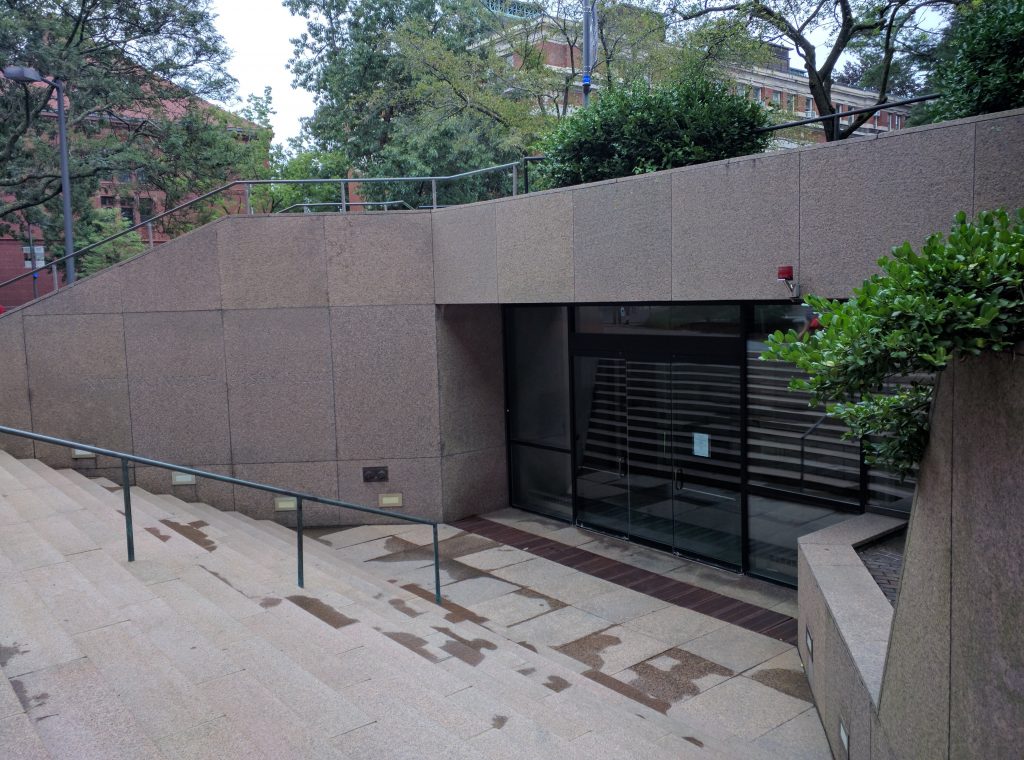
Theodore H. White Papers (Harvard University Archives): 50%
White, a journalist and historian who wrote several books in what’s known as his The Making of the President series, took on the challenge of describing American political culture through its quadrennial elections beginning in 1960. He took a break in 1976, and in 1980 followed both the Democratic and Republican primaries, eventually producing his last major political monograph, America in Search of Itself: The Making of the President, 1956-1980. While I have the book, I was curious about some of the interviews, notes, and conversations that went into the production of the book, particularly around Hubert H. Humphrey’s role in the 1976 election and Walter Mondale’s vice presidency.
National Organization of Women Records (Schlesinger Library, Radcliffe Institute, Harvard University): 30%
The NOW was founded in 1966, but by the mid-1970s had pivoted to securing passage of the Equal Rights Amendment (ERA) to the Constitution, which would have guaranteed men and women equal protection under the law. NOW operated with a number of chapters across the country, usually situated on metropolitan areas. After many states, including the Dakotas and Iowa, had passed the ERA, though, the conservative revolution associated with the New Right and Ronald Reagan in the late 1970s sought to rescind state legislatures’ ratification of the ERA (a process called rescission).

My interest in the NOW papers was (and remains!) twofold: To get more local pictures into feminist activism in the Upper Midwest, and to understand the state-level political conflicts over equal rights and rescission, liberalism and conservatism. For example: There was a Marshall, MN, chapter of the NOW! I did not know that, because no records for the Marshall chapter exist, either at Southwest Minnesota State University in Marshall or the Minnesota Historical Society Library. That’s not those archives’ fault; it’s just how records were saved and donated. Hence the need to go to Boston! I found a couple documents from the president of the Marshall NOW in 1985 that will be foundational to the tensions between national liberal organizations like NOW and local concerns in the Upper Midwest.
Janis Pryor Papers (Schlesinger): 20%
The 1988 Jesse Jackson campaign is playing a focal point in Chapter 6 (1984-1988), which I’m currently struggling through. If you looked at my write-up on Ames (sorry), you may have noticed that some of these radical farming organizations like the North American Farm Alliance REALLY liked them some Rainbow Coalition.
The problem? While Jackson campaign managers and workers have written memoirs and recollections, I have yet to see the real, uncensored, internal nitty-gritty of the Jackson campaign, which sought to blend urban concerns with those of a broad, multiethnic working class under the banner of the Rainbow Coalition.
The papers of Janis Pryor, a political communications and media consultant, help fill that gap. Her collections represent a window into how the Jackson image was crafted in such a way that it linked up with prominent Midwestern liberals, including Paul Wellstone of Minnesota, who co-chaired the Jackson campaign in Minnesota. This collection required Janis’s permission to access; I am deeply indebted to her for the trust and willingness to open her collections to me.
Findings
I have to keep this short–I’ve already rambled too much about why I’m in Boston. So I’m going to do one bullet point for each collection, and you’ll have to read the rest in the dissertation or manuscript!

- T.H. White and the debate over populism and liberalism: I’ve made no secret that this generation of “progressive populists”–Tom Harkin, Paul Wellstone, etc., etc., etc.–sought to reclaim the “populist” mantle, both from more conservative Southerners and New Right conservatives like Richard Viguerie. But defining this was harder: Carter reportedly got frustrated with a White correspondent on the campaign train in 1976, rhetorically asking “How do you define liberalism? How do you define honest or love? How do you define compassion or understand? Are all those words part of what you define as populism?”[1]
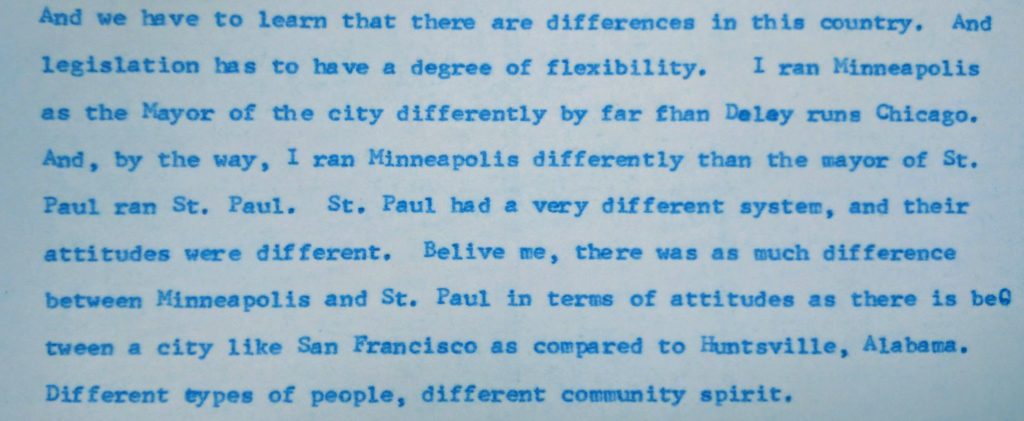
- Humphrey, on the other hand, was frustrated by 1976 with liberals in the Democratic Party: He believed that one of the problems I have seen with many liberals is they never were so unhappy as when they are happy, they’ve never been so happy as when they were unhappy… But we’ve got to be pragmatists, at the same time that we’re principled.”[2]
This was part of a broader debate among Democrats over the need for compromise or definition in liberal policymaking, and the 1976 and 1980 campaigns (there’s some great stuff on the Ted Kennedy primary campaign for president) lay bare the struggle among Democrats, especially in the late 1970s, to balance broad national visions with their home context–the “good ol’ boy” nature of Georgia politics, the historically-Scandinavian piety of Minneapolitan progressivism, or the passion of New England liberalism. Lots more to unpack.
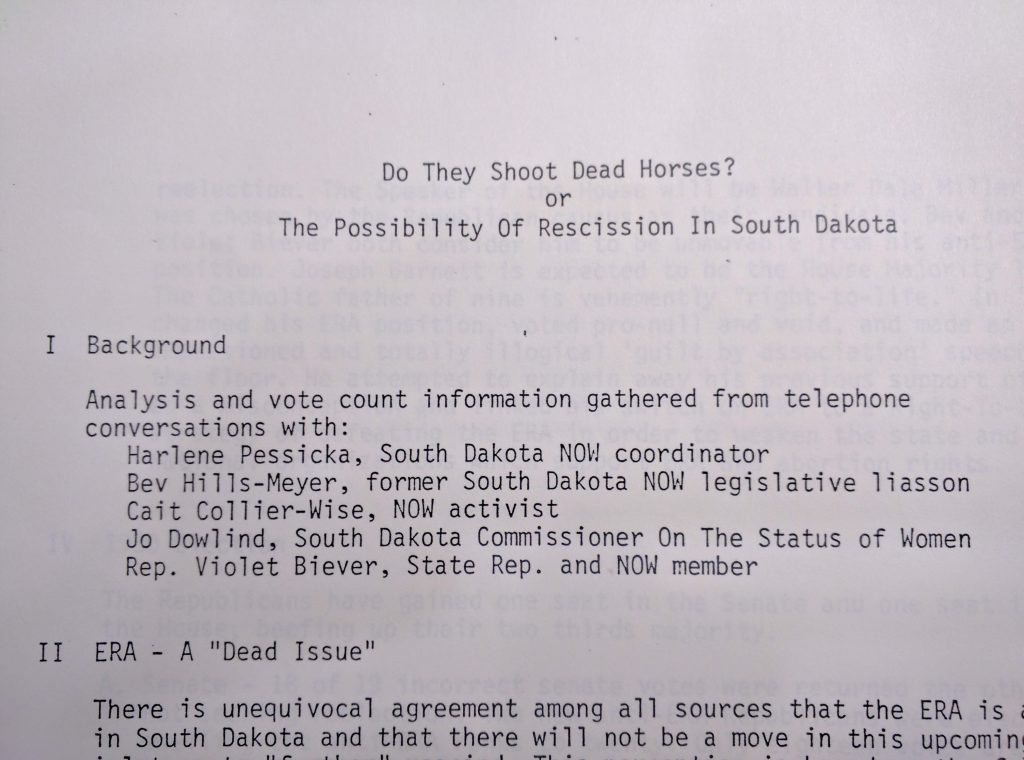
- How did the NOW fight for feminism locally in the Midwest? Not well.
That’s not entirely true. But read scathing letters from Iowa feminists excoriating the NOW president for an unauthorized, condescending letter to Iowa TV networks amid the state’s own state constitution ERA fight in 1980 or the president of the Marshall, MN, chapter confiding “I do not want NOW to become an east coast/west coast organization (something it already has problems with),” and you can see that local feminists differed with their national organization, particularly president Eleanor Smeal, in how things should be done.[3]
These weren’t completely debilitating differences, of course, but it helps me get at how national concerns–from a never-before-seen South Dakota memo with an amazing title (see pictured) to local lists of (un)friendly legislators’ positions on the ERA–played out in and differed from local contexts. There’s more to do here, particularly in the local publications of NOW chapters from Fargo to Vermilion and Madison to Minneapolis that I’d not seen before. - Jackson tapped into a progressive vein, and revealed a different vision of the Midwest. It’s odd to see “IOWA — very liberal!” in many of the sources I read, but there was communications consultant Janis Pryor, noting the differences between the Iowa caucuses and New Hampshire primaries in 1988 (which I’ve also explored in the papers of Paul Simon).[4] The Farm Crisis of the mid-1980s, which I’ve described elsewhere as animating a vocal subset of progressive farm activists who supported Jackson, became a flashpoint for Jackson’s support in the Upper Midwest. As the Jackson campaign encouraged him to “re-establish the [National Rainbow Coalition] in the consciousness of the public,” his advisers distinguish Midwestern farmers from both “Traditional Liberals” and “Southern (Conservative) Democrats.”[5]
That the Jackson campaign pushed his candidacy as the “progressive” one in 1988, noting that the Midwest was “in crisis” unlike the Northeast, the traditional base of Michael Dukakis, his identification of the “Midwest” with the health of the family farm goes a long way in helping my analysis establish both the regional identity assigned to the Midwest and the ways in which Midwestern Democrats did differ from those elsewhere. As one of the challenges DNC pollsters warned Dukakis of was making his message of the “Massachusetts Miracle” “applicable to meeting the economic challenges [voters] face in their own geographic area,” I think I’ve identified ways in which Jackson did that in a way very differently than Dukakis.[6]
There were some more excellent finds from these varied collections, particularly on the dual, occasionally-intertwined forces of populism and progressivism in the Democratic Party during the 1980s. Stay tuned.
The City
It’s 100% impossible to write about Boston in one, two, or even four blog posts; and it’s ambitious that I’ll write more than one in this installation. What I’ll try to cover, though, are a few things: How I got around in Boston, my weekend trip to Gloucester and Salem, and my wife Laura coming to visit me, culminating in a whirlwind 24-hour trip to Maine.
Lodging
The last time I was in Boston, I stayed in an Airbnb just south of the Orange Line in the working-class suburb of Roslindale. This time, I decided I wanted late-night train service and fewer transfers to my archives, so I found a place in Braintree, at the southern end of the Red Line, acknowledging that while I’d have a 50-minute (at best, I learned!) commute to Harvard, it would be a straight, simple shot.

I was lucky in my lodging; Peter and Clovis, my Airbnb hosts, were unfailingly kind and responsive, even going so far as to re-clean and -make the room for Laura’s visit! I had just a .7-mile walk to the Red Line and commuter rail (more on that later), and an A/C unit right next to my bed, which came in handy as temps spiked close to 100 degrees. And their cat, Oreo, loved scratches and playing–giving me something to try and fill the gap left by not having Moe, my erstwhile supervisor back home.
I was unlucky in my transit; a Red Line derailment has wreaked havoc on the southern end of the route, meaning that after 8:45pm I would actually have to get off four stops from Braintree, board a bus, and ride it to my destination. Further, the Red Line was subject to a number of delays and stoppages as trains had to wait for signal clearance and open platforms while crews worked to repair the lines.
Boston Things

Brewery of Note: I went to a few really good ones, including the (surprisingly-small) Samuel Adams taproom, where Laura and I split a couple flights and played cribbage.. I tend to associate Sam Adams with Boston Lager and Summer Ale, but Laura (marathoner that she is!) was very excited to try their 26.2 ale, which is apparently given out to runners of the Boston Marathon. I really enjoyed the Minnesota Nice IPA, which felt appropriate at the time.

The other brewery that I visited a few times and really enjoyed–I got a lot of writing done and Nina the bartender was friendly–was Aeronaut Brewing Co., a two-mile walk from campus over in Somerville. Their Year with Dr. Nandu line of IPAs and Double IPAs was really enjoyable, as was the Hermann Hesseweizen, which has the added bonus of being an A+ name for a beer. Big, open space, lots of cool events, including a jazz combo and weekly trivia, and attached farmers’ market-type stalls where craft chocolates and some other stuff are apparently sold.
Other can’t-miss places and beers? I met up with an old quiz bowl teammate, Anant, at Lamplighter Brewing in Cambridge and we both enjoyed the cherry sour; Remnant Brewing in Somerville had an awesome outdoor plaza seating area and a really juicy pale ale (and now I’m upset they didn’t have the sour saison on tap when I was there). I also made a…decision…to walk the three miles to Winter Hill Brewing, and they had both good coffee and an easy-drinking Kolsch.
Up the Coast, Pt. I
My first weekend in Boston, temps were high and I did not feel like sitting in a confined room all day; the answer was to make liberal use of the MBTA’s Weekend Commuter Rail Pass, giving me as many rides (which usually cost a minimum of $5 or so, and $7 to Braintree) as I wanted for just $10. So I decided to do a little brewery tourism, heading up the Rockport Line to both Salem and Gloucester.
I had originally planned to go to Cape Cod, but at the suggestion of my friend Cathy Stock–check out her book on militarization and the rise of the rural New Right, coming to a shelf near you in summer 2020!–I decided to go north rather than south.
Salem
About Salem, I’ll be honest: I don’t like teaching it in my classes. Never have. So I was not stopping at the Peabody Essex Museum, though I’ve now been informed how great a mistake this was. Next time, I promise. Instead, with a couple things to do for work, I found Salem’s two main breweries: Notch and East Regiment. Here, unsolicited and mostly unedited, are my notes from each:
East Regiment
Cool little downtown storefront space; nice brick patio and lots of treated wood. There’s the smell of horse manure wafting in from somewhere, which is unpleasant, but it’s got a nice little view of a church. That’s Salem enough for me.

- Baker’s Brown: Nutty, very smooth.
- Bravo Alpha Foxtrot Porter: Does this have coffee? It gets a weird chocolatey taste.
- Making Gains DIPA: Hoppy with nice tropical bouquet and a crisp finish. (I made a note here to myself of how pretentious I sound.)
- Biere de Garde: Almost…tropical? Spiciness comes out as it warms up. I like it, but I’m not sure how true to the style it is. Improves its sweet/spiciness as it warms up.
- Strawberry Wheat: Light, crisp, subtle strawberry but nothing I’m going back to unless it’s a hot summer day and I need something super light oh wait it’s 84 out. [I wrote this unironically, to myself, in my Notepad app. I’m sorry.]
- Pineapple Wheat: A little tart, a little tropical, but you could just tell me this was a tropical wheat and I’d believe you fine.
- Mango Wheat: the flat, smooth taste of mango hits you–it’s not like a beer, it’s like you’re biting into the fruit–and kind of masks the rest of the wheat flavor.
They had a vote going to help them choose which of those wheats would be their next flavor; I obviously chose the Strawberry. Feel free to ship me as much of it as you’d like, East Regiment.
Notch Brewing Co.
On first glance–BEAUTIFUL! An old brick warehouse right on the wharf/river/canal, it’s been gutted and renovated while keeping everything–the brick, the wood beams, the whole nine yards.
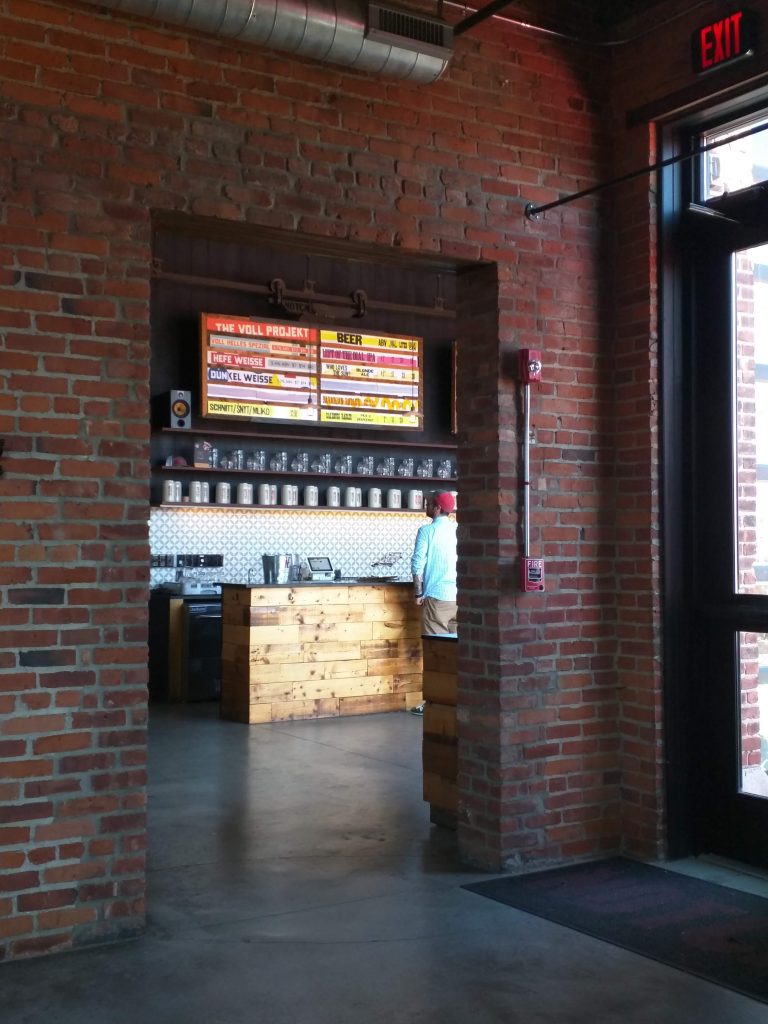
A nice new bar and tap system, too. Everything here sold by the half- and full-liter, which is unexpected but nice. Most of their stuff is in a German tradition: A Helles, Hefe, Dunkel, and two radlers mark the German offerings, while a Czech pils, Czech pale lager, and Altbier mark the more eastern fare. Then there’s the Blonde Ale I was recommended, plus an IPA, smoked lager, and American corn lager.
- Blonde Ale: Supposedly fruity, it’s cold-fermented with kolsch yeast. It’s fine. I don’t know I’d do a half-liter again. Good for its style.
- I had to rush through the smoked lager, as the next train to Gloucester was coming, but I enjoyed this one more. I’d love to come back and work my way through the standard German and Czech sessions.
Other Salem Things:
I did walk around Salem for a while, checking out the still-existing structures from the Witch Trials and walking past the cemetery where 17th-century residents of Salem are still buried.
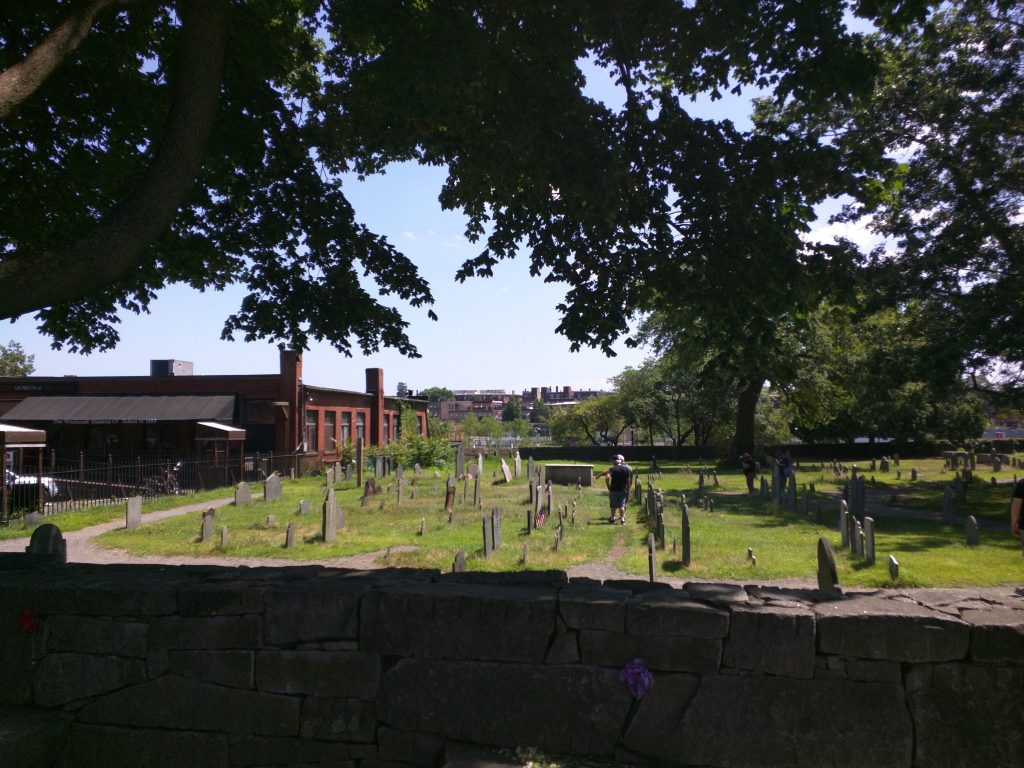
On the whole, though, Salem was a little odd for me. It’s uncomfortable to see something as tragic as a mass panic resulting in the deaths of 20 people turned into a cheap amusement with haunted houses, face-painted walking tours, and the moniker “Witch City.”
Gloucester
My time in Salem, ultimately, spanned about two hours. I did a little work at East Regiment, did a hurried walking tour of town on my way to Notch, and speed-walked back to the train station to catch the next train up to Gloucester.
Gloucester, a blue-collar fishing town on Massachusetts’ North Shore, has been represented in everything from Rudyard Kipling to The Perfect Storm, and monuments to its fishing heritage are plentiful. I was interested, though, in seeing two things: the Man at the Wheel statue and Cape Ann Brewpub. (Of course–my Man at the Wheel statue picture didn’t take like I thought, but the Cape Ann pictures did…)
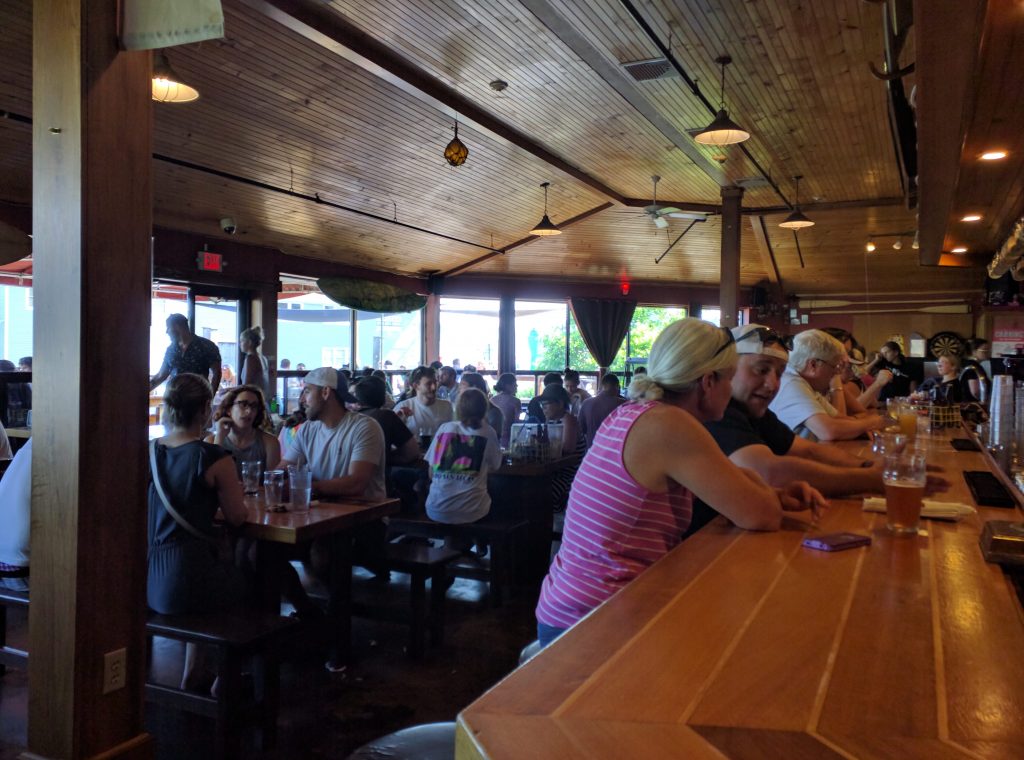
Cape Ann Brewing Co. is an older (relative to most) microbrewery that’s also run a successful restaurant operation, meaning the brewing doesn’t necessarily take a backseat to the food, but that it’s not a “sit at the counter and talk brewing with the bartenders” kind of place. It’s got a great patio, though–and I met a couple at the outdoor deck bar, one of whose mothers hailed from Alexandria, MN! Small world. Of the three beers I had, I would go to bat over enjoying the cherry sour stout. Good mussels, too.
Up the Coast, Pt. II
Laura came to visit me! That was exciting, because I’m usually alone on the road for the better part of 12-14 days when I do these extended research trips (though I’ve been lucky to meet up with friends on all of them). And, since we both needed to check off New Hampshire, she needed to check off Rhode Island, and I needed to check off Maine for the “states we’ve visited/walked around in” list, we decided to rent a car from Providence (mostly because any reputable company was $80-100 cheaper than Boston Logan) and drive up to Maine.
We stayed overnight in an Airbnb in Topsham, spending our Friday night traveling to various attractions from Moderation Brewing in Brunswick to the 24-hour LL Bean store complex in Freeport (does it get more Maine?), then slowly made our way down the coast to Portland for the day on Saturday before getting her back to the airport for an early Sunday flight. Hit the highlights, Cory:

- Moderation Brewing Co: A small storefront brewery on Brunswick’s Maine Street. We did a flight, a slug we named Sid somehow crawled up onto the armrest of Laura’s chair, a good time was had by all. Support them and their good initiatives, and get the As Time Gose By lime gose.
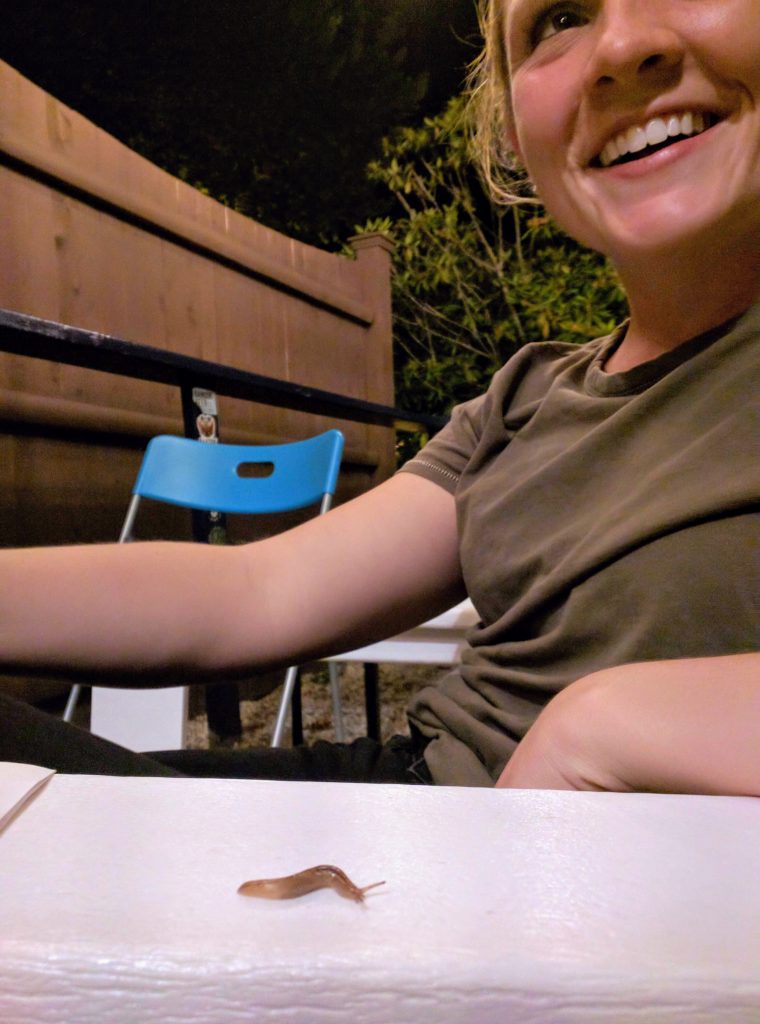
- Broadway Delicatessen: We were originally going to a different place for breakfast in Brunswick (just across the river from Topsham), and then they were busy, so we walked into this cute little diner. Friendly service, and the best salmon eggs benedict I’ve ever had.
- Cold River Distillery: As we headed down US Route 1 toward Portland, a barn-style distillery caught me eye. Turns out this is one of Maine’s oldest breweries, doing potato vodka from local potatoes, and a blueberry-infused vodka that Laura (!!!) said she could drink straight, over ice. I wish I would have had room in my suitcase to bring a bottle back…

- Portland Head Light: Referred to by my friend Greg as the “Basic Lighthouse,” Laura and I did indeed do your “suburban white kids on vacation” photoshoot at the lighthouse, climbing down the rocks and taking in the seascape while enjoying the historic lighthouse.
The Shop, for oysters: Recommended to us by the tasting pourer at Cold River, The Shop is a by-the-oyster restaurant in Portland with a great selection of local seafood. We did two of each of their Maine oysters, and it was the first time Laura had ever had any! I was amazed she liked them; I thought they were delicious but probably couldn’t pick a major difference among the varieties if you paid me.
Shipyard Brewing: One of the major breweries in Maine (the other being Allagash, which we just didn’t have time in our 24 hours to go to), Shipyard did something I really enjoy, being basically telling their visitors to create their own flight with readily-available chalk and flight racks. I particularly enjoyed their Tea Brew series, and their New England IPA was (obviously) really good.

Did you do anything in Boston?!
I did! But this is already getting too long and you probably don’t care. So here are a couple of the highlights I hit around Harvard’s campus:
Food near Harvard
In short order:


Mr. Bartley’s Burgers (Cambridge): Literally across the street from the Widener Library. I’d been here a long time ago, so it was great to come back. Great shakes and creative burgers named for topical political figures and events — twelve years ago I got the Ted Kennedy (a mushroom and swiss burger), and this time I got the Admissions Scandal with bleu cheese.

Felipe’s (Cambridge): A chimichanga the size of my forearm for $9.50 is a good deal, and the baja fish tacos with fried shrimp were delicious as well. Right next to the Harvard Red Line station.
Orinoco (Cambridge): A Venezuelan restaurant just south of campus on Kennedy Ave, recommended to me by the inimitable Sam Harshner. I had the Mechada empanadas.
Other Things I Did/Ate
- A lobster roll at Luke’s Lobster. Are there better places? Perhaps. But it’s downtown, it’s quick, and it’s delicious. And they make it without mayo, and I cannot think of a cause I feel more strongly about than avoiding the scourge of mayo at all turns.
- Laura and I got a bowl of clam chowder at Faneuil Hall, which was uneventful but enjoyable. We then walked through Boston Common, picking up the Freedom Trail to Paul Revere’s house, and also ate a cannoli from Mike’s, which is, I think, the most Boston tourist-y sentence I can write.
- I didn’t go there on this trip, but I will always vouch for Martin’s Coffee Shop in Brookline. Delicious omelettes in a really simple diner-style setting.
Did you stick out like a sore, Midwestern thumb?
Reader, I did. One person asked if I was from Canada, which the couple at the Gloucester brewery correctly pinpointed me as being from Minnesota on the first crack. I told a woman on the T that she dropped her bag, and a man commented not on my politeness, but on how I pronounced “bag” (correctly, I informed him).
The one place that I felt simultaneously like an outsider and at home was when I went to Mass both Sundays in Braintree. (I generally leave these parts out of my blog posts, but I’ll tease that I’ve never felt more uncomfortable than during a homily on papal infallibility during the Assumption at a church in Grand Forks, ND.)
Anyways, I went–out of sheer convenience–to St. Francis of Assisi Church in Braintree, and I may have found my favorite parish ever. While it was jarring to have a reader who looked like Ted Kennedy (full head of white hair) intone readings on “Gawd” and “the Lawd”, it was really a pleasure to be part of such a reverent and yet inviting Mass. Upon finishing the Gospel on the Good Samaritan, Fr. Paul, the presider for both Masses I attended, leaned his right elbow on the ambo, fiddled absentmindedly with the book, and gave a simultaneously hilarious, self-deprecating, and thought-provoking homily about seeking those in our midst who we normally look past.
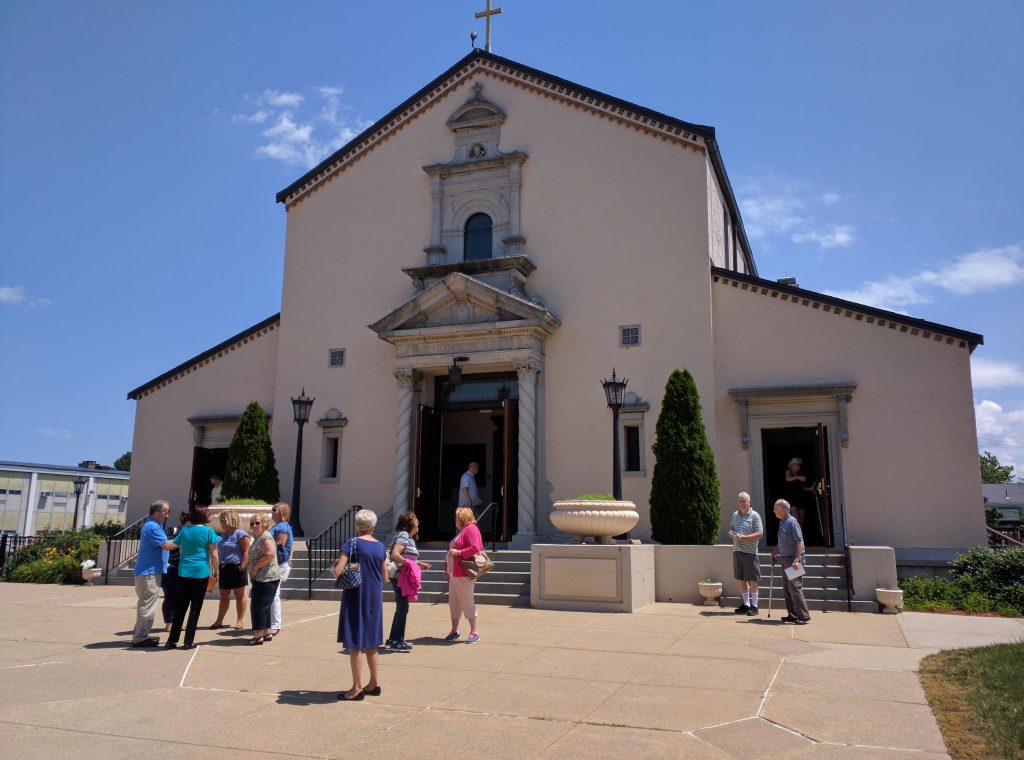
Again, though, it’s a jarring thing to be in church and be preached at in an accent that’s not my own. It was odd a couple weeks ago in Louisville to hear “Alleluia” and “Amen” in a Southern drawl, and to hear Fr. Paul use “wicked awesome” unironically and unsolicited twice in one homily had me looking around nervously and wondering if this was all a practical joke. I loved my time at St. Francis, and I will happily go back when I’m in Boston next.
What’s next?
Writing! Lots and lots of writing. I’m close to being done with a first draft of the dissertation, and now it’s time to kick the writing output into overdrive, save for the occasional day trip.
Edited update: By the time I remembered to post this, I actually started teaching! I am currently lecturing at St. Cloud State University in St. Cloud, MN, teaching one course on U.S. history post-Civil War.
If you made it this far, thanks for reading! Sorry I was so long-winded. Feel free to leave me recommendations for my next trip to Boston or give me thoughts on the research or findings.
Past Trips: Where I’ve Been
Ames
Carbondale
Pierre
Iowa City
Bloomington
St. Paul, St. Cloud
Menomonie
Milwaukee
Iron Range, Lake Vermilion Edition
Grand Forks
River Falls
Iron Range, Biwabik Edition
Bismarck-Mandan
Des Moines
Fargo-Moorhead
Stevens Point
[1] Stan Cloud (by phone to newsdesk from Plains, Georgia) to Time Nation, July 16, 1976, 1. White Papers, Box 161, Folder 10.
[2] “Theodore White Interview with Hubert Humphrey: The Humphrey Perspective on Modern American History,” April 22, 1976, Minneapolis, MN, 21-22. White Papers, Box 161, Folder 12.
[3] Peg Anderson to Eleanor Smeal, October 13, 1980. NOW Papers, Box 120, Folder 32; Lynn Seeling to Kate Wulf, August 27, 1985, 1. NOW Papers, Box 169, Folder 8.
[4] Janis Pryor, handwritten notes in personal journal, undated. Pryor Papers, Box 6, Folder 7.
[5] Janis Pryor and Paul T. Poghosian, “Communications Management: Policy, Procedures and Organization,” submitted to Yolanda Caraway and Bertrum M. Lee at the request of the National Rainbow Coalition, December 3, 1985, 1, 24-25. Pryor Papers, Box 6, Folder 10.
[6] “Talking Points for the Democratic National Convention,” Peter D. Hart Research Associates, Inc., July 1988, 7. Pryor Papers, Box 7, Folder 2.

